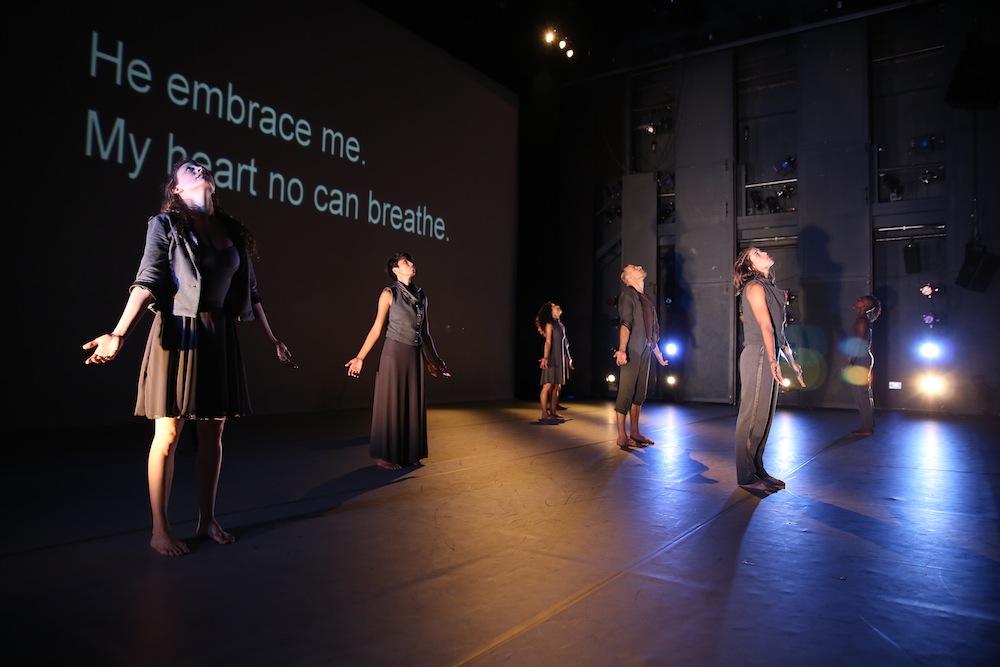By Noah J. Nelson (@noahjnelson)
Technology and performance make dangerous dance partners for theater.
"Stardust", a new dance-theater piece from writer-director-choreographer David Roussève, took a preview bow in Los Angeles this past week as part of the Radar L.A. international contemporary theater festival based out of the REDCAT* space in Downtown L.A.. The performance took on the challenge of mixing dance, projected text, and spoken word not just for art's sake, but as a means of tackling the ways that technology allows us to express our inner lives.
We spoke with Roussève about this ambitious project that will be touring the country early next year.
Roussève said that "Stardust" is about "the tension between intimacy and technology and how complicated a brew that is."
Roussève explores that tension through the story of J.R., a young gay African-American man struggling with his identity against the backdrop of a judgmental church culture and the pressure to conform. J.R. is torn between the impulse to fit in, which leads him to act the part of the thug, and a deeper desire to do the right thing.
The catch is: we never see the lead character. J.R.'s presence is felt through the projection of text messages sent to strangers and illustrated by the choreography executed by Roussève's corps of athletic dancers. The clash of technology and human emotion in the narrative is embodied by the clash of technology and human motion on stage.
"So there was a tension there that we were playing with," said Roussève, "between anonymity, invisibility, intimacy and presence. Ironically not being present gives him the most feeling of intimacy that he has in his life."
Part of J.R.'s desire to find solace with strangers is borne out of the rejection he finds in the religious community he is a part of. His hidden identity as a homosexual comes under fire from his town's pastor. J.R. seeks to understand his place in the universe by turning to what he calls "the Innernet", which Roussève explains is how the character hears "Internet".
"So he finds his God, someone who he can always turn to. Someone who is always there. Someone who has these mystical powers of being but not being. Someone who hears and reads our prayers. He finds his version of God through technology. Through the Internet and sending out these text messages that no one reads."
Roussève remains fascinated by the tension within this idea.
"There's actually something quite beautiful in that and actually something quite dangerous in it at the same moment. It starts to represent this solace to him while also being a dangerous place for a child to find God."
Roussève teaches at UCLA, and compares his own religious upbringing as a "good little Catholic boy" comforted by the idea of an impersonal God who hears his secret confessions with that of his students.
"Now everything has to be witnessed. In the era of reality TV, it's not enough to pray to God, I actually have to pray and have someone hear them.
"I thought: 'Wow. It's almost like the feelings don't exist anymore unless they're witnessed.' There's something really beautiful about that thought: another human being has to experience my life for it to have validity."
Again Roussève sees danger, and irony, in that concept.
"Unless someone knows my secrets, they don't really exist as secrets. That's ironic because a secret is something no one knows."
While the textual elements carry the narrative of J.R.'s life, Roussève sees the dance portion of the piece as driving the emotional core. As the tension between technology and intimacy is thematically explored in "Stardust", a tension between dance and narrative is used to uncover layers of meaning that would be harder to discover using one medium alone.
Not that the use of disparate disciplines-- dance, video, projection--doesn't come with their own set of headaches.
"I've never created a piece that's so steeped in technology. With three projectors going at the same time, and trying to time lighting, projector A, B and C and dancing. It was the biggest nightmare in all my years of creating work. Every minute I'm sitting in there going 'I will never work with technology again.'
"Then you see the end result and say, 'How could I not work with technology again?'"
"Stardust" will have its official World Première January 31st, 2014 in the Clarice Smith Performing Arts Center at the University of Maryland.
*Roy and Edna Disney/Cal Arts Theater
Image: Video Art by Cari Ann Shim Sham and dancers in David Roussève's Stardust at Radar L.A.
Photo Credit: Steven Gunther.
Originally published on Turnstylenews.com, a digital information service surfacing emerging stories in news, entertainment, art and culture; powered by award-winning journalists.
